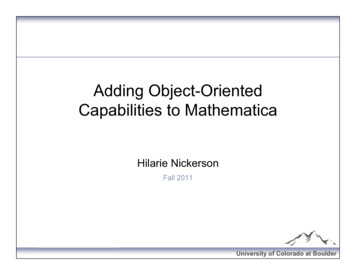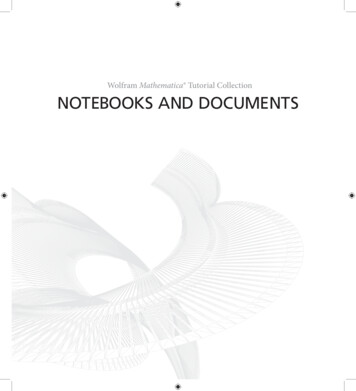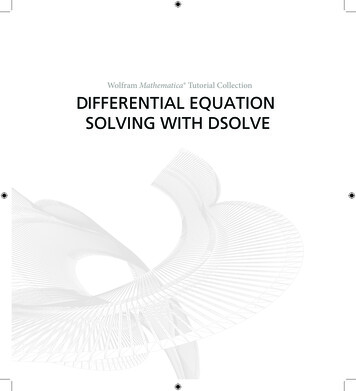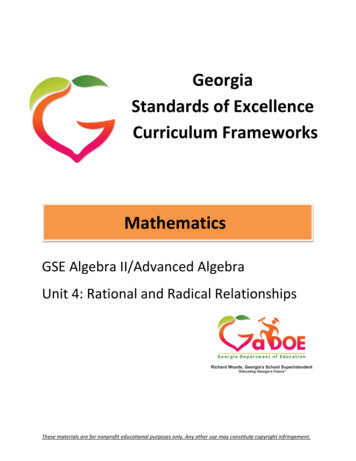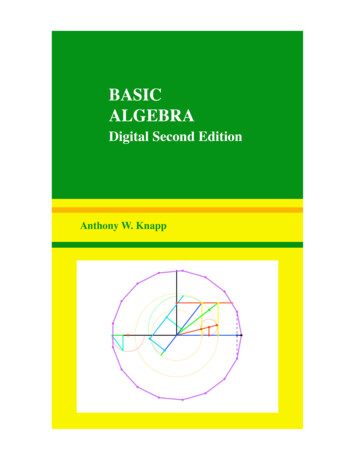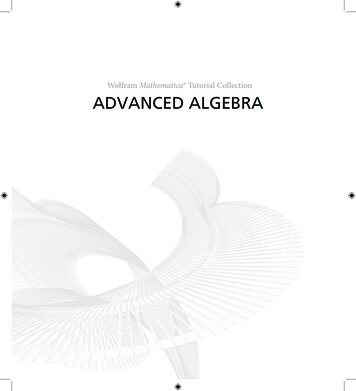
Transcription
Wolfram Mathematica Tutorial CollectionADVANCED ALGEBRA
For use with Wolfram Mathematica 7.0 and later.For the latest updates and corrections to this manual:visit reference.wolfram.comFor information on additional copies of this documentation:visit the Customer Service website at www.wolfram.com/services/customerserviceor email Customer Service at info@wolfram.comComments on this manual are welcomed at:comments@wolfram.comContent authored by:Adam Strzebonski and John NovakPrinted in the United States of America.15 14 13 12 11 10 9 8 7 6 5 4 3 2 2008 Wolfram Research, Inc.All rights reserved. No part of this document may be reproduced or transmitted, in any form or by any means,electronic, mechanical, photocopying, recording or otherwise, without the prior written permission of the copyrightholder.Wolfram Research is the holder of the copyright to the Wolfram Mathematica software system ("Software") describedin this document, including without limitation such aspects of the system as its code, structure, sequence,organization, “look and feel,” programming language, and compilation of command names. Use of the Software unlesspursuant to the terms of a license granted by Wolfram Research or as otherwise authorized by law is an infringementof the copyright.Wolfram Research, Inc. and Wolfram Media, Inc. ("Wolfram") make no representations, express,statutory, or implied, with respect to the Software (or any aspect thereof), including, without limitation,any implied warranties of merchantability, interoperability, or fitness for a particular purpose, all ofwhich are expressly disclaimed. Wolfram does not warrant that the functions of the Software will meetyour requirements or that the operation of the Software will be uninterrupted or error free. As such,Wolfram does not recommend the use of the software described in this document for applications inwhich errors or omissions could threaten life, injury or significant loss.Mathematica, MathLink, and MathSource are registered trademarks of Wolfram Research, Inc. J/Link, MathLM,.NET/Link, and webMathematica are trademarks of Wolfram Research, Inc. Windows is a registered trademark ofMicrosoft Corporation in the United States and other countries. Macintosh is a registered trademark of AppleComputer, Inc. All other trademarks used herein are the property of their respective owners. Mathematica is notassociated with Mathematica Policy Research, Inc.
ContentsComplex Polynomial Systems . . . . . . . . . . . . . . . . . . . . . . . . . . . . . . . . . . . . . . . . . . . . . . . . . . . . .1Real Polynomial Systems . . . . . . . . . . . . . . . . . . . . . . . . . . . . . . . . . . . . . . . . . . . . . . . . . . . . . . . . . .24Diophantine Polynomial Systems . . . . . . . . . . . . . . . . . . . . . . . . . . . . . . . . . . . . . . . . . . . . . . . . .74Algebraic Number Fields . . . . . . . . . . . . . . . . . . . . . . . . . . . . . . . . . . . . . . . . . . . . . . . . . . . . . . . . . . 105Solving Frobenius Equations and Computing Frobenius Numbers . . . . . . . . . . . . . . 119
Complex Polynomial SystemsIntroductionThe Mathematica functions Reduce, Resolve, and FindInstance allow you to solve a widevariety of problems that can be expressed in terms of equations and inequalities. The functionsuse a collection of algorithms applicable to classes of problems satisfying particular properties,as well as a set of heuristics that attempt to reduce the given problem to a sequence of problems that can be solved using the algorithms. This tutorial describes the algorithms used tosolve the class of problems known as complex polynomial systems. It characterizes the structure of the returned answers and describes the options that affect various aspects of the methods involved.A complex polynomial system is an expression constructed with polynomial equations andinequationsf Hx1 , , xn L ã gHx1 , , xn L and f Hx1 , , xn L gHx1 , , xn Lcombined using logical connectives and quantifiersF1 Ï F2 , F1 Í F2 , F1 fl F2 , Ÿ F, "x F, and x F.An occurrence of a variable x inside "x F or x F is called a bound occurrence, and any otheroccurrence of x is called a free occurrence. A variable x is called a free variable of a complexpolynomial system if the system contains a free occurrence of x. A complex polynomial systemis quantifier-free if it contains no quantifiers.Here is an example of a complex polynomial system with free variables x, y, and z.x2 y2 ã z2 Ì t J"u t x u y z 7 Î x2 t ã 2 z 1N(1)In Mathematica, quantifiers are represented using the functions Exists ( ) and ForAll (").Any complex polynomial system can be transformed to the prenex normal formQ1 x1 Q2 x2 Qn xn FHx1 , , xn ; y1 , , ym L,where each Qi is a quantifier " or , and FHx1 , , xn ; y1 , , ym L is quantifier-free.Any quantifier-free complex polynomial system can be transformed to the disjunctive normalform
2Advanced AlgebraAny quantifier-free complex polynomial system can be transformed to the disjunctive normalformIj1,1 Ï Ï j1,n1 M Í Í Ijm,1 Ï Ï jm,nm M,where each ji, j is a polynomial equation or inequation.Reduce, Resolve, and FindInstance always put complex polynomial systems in the prenexnormal form, with quantifier-free parts in the disjunctive normal form, and subtract the sides ofthe equations and inequations to put them in the formf Hx1 , , xn L ã 0 and f Hx1 , , xn L 0.In all the tutorials for complex polynomial system solving, assume that the system has beentransformed to this form.Reduce can solve arbitrary complex polynomial systems. The solution (possibly after expandingfl with respect to fi) is a disjunction of terms of the formgx1 r1 Ï g1 Hx1 L 0 Ï x2 r2 Hx1 L Ï g2 Hx1 , x2 L 0 Ï -1 Hx1 , , xn-1 L 0 Ï xn rn Hx1 , , xn-1 L Ï gn Hx1 , , xn L 0,(2)where x1 , , xn are the free variables of the system, each gi is a polynomial, each ri is an algebraic function expressed using radicals or Root objects, and any terms of the conjunction (2)may be absent. Each ri Hx1 , , xi-1 L is well defined, that is, no denominators or leading terms ofRoot objects in ri become zero for any Hx1 , , xi-1 L satisfying the preceding terms of the conjunction (2).This solves the system (1).In[1]: ReduceAx2 y2 ã z2 && t I"u t x u y z 7 »» x2 t ã 2 z 1M, 8x, y, z EOut[1] Hy ã 0 && z ã -xL »» Hy ã 0 && z ã xL »» HHy ã -Â x »» y ã Â xL && z ã 0L »»zã-x2 y2 »» z ãx2 y2&& x 0 »» x ã 0 && y ã -1&& z ã -212»» x ã 0 && y ã12&& z ã -12Resolve can eliminate quantifiers from arbitrary complex polynomial systems. If no variablesare specified, the result is a logical combination of termsf Hx1 , , xn L ã 0 and gHx1 , , xn L 0,where f and g are polynomials, and each xi is a free variable of the system. With variablesspecified in the input, Resolve gives the same answer as Reduce.This eliminates quantifiers from the system (1).
Advanced Algebra3This eliminates quantifiers from the system (1).In[2]: ResolveAx2 y2 ã z2 && t I"u t x u y z 7 »» x2 t ã 2 z 1ME22Out[2] Hy ã 0 && x - z ã 0L »» Hy ã 0 && x z ã 0L »» Ix y ã 0 && z ã 0M »» Hx ã 0 && -1 2 y ã 0 && 1 2 z ã 0L »»Hx ã 0 && 1 2 y ã 0 && 1 2 z ã 0L »» Ix2 y2 - z2 ã 0 && y - z 0 && y z 0MFindInstance can handle arbitrary complex polynomial systems giving instances of complexsolutions, or an empty list for systems that have no solutions. If the number of instancesrequested is more than one, the instances are randomly generated from the full solution of thesystem, and therefore they may depend on the value of the RandomSeed option. If one instanceis requested, a faster algorithm that produces one instance is used, and the instance returnedis always the same.This finds a solution for the system (1).In[3]: FindInstanceAx2 y2 ã z2 && t I"u t x u y z 7 »» x2 t ã 2 z 1M, 8x, y, z EOut[3] 88x Ø 0, y Ø 0, z Ø 0 The main tool used in solving complex polynomial systems is the Gröbner basis algorithm [1],which is available in Mathematica as the GroebnerBasis function.Gröbner BasesTheoryThis section gives a very brief introduction to the theory of Gröbner bases. It presents only theproperties that are necessary to describe the algorithms used by Mathematica in solving complex polynomial systems. For a more complete presentation see, for example, [1, 2]. Note thatwhat [2] calls a monomial, [1] calls a term, and vice versa. This tutorial uses the terminology of[1].A monomial in x1 , , xn is an expression of the form x1 e1 xn en with non-negative integers ei .Let M MHx1 , , xn L be the set of all monomials in x1 , , xn . A monomial order is a linear order Çon M, such that 1 Ç t for all t œ M, and t1 Ç t2 implies t1 s Ç t2 s for all t1 , t2 , s œ M.Let R be a field, the domain of integers, or the domain of univariate polynomials over a field.Let Quot and Rem be functions R2 ö R defined as follows. If R is a field, QuotHa, bL a ê b, andRemHa, bL 0. If R is the domain of integers, Quot and Rem are the integer quotient and remainderfunctions, with - b ê 2 RemHa, bL § b ê 2. If R is the domain of univariate polynomials over afield, Quot and Rem are the polynomial quotient and remainder functions.
4Advanced AlgebraLet R be a field, the domain of integers, or the domain of univariate polynomials over a field.Let Quot and Rem be functions R2 ö R defined as follows. If R is a field, QuotHa, bL a ê b, andRemHa, bL 0. If R is the domain of integers, Quot and Rem are the integer quotient and remainderfunctions, with - b ê 2 RemHa, bL § b ê 2. If R is the domain of univariate polynomials over afield, Quot and Rem are the polynomial quotient and remainder functions.A product t a m, where a is a nonzero element of R and m is a monomial, is called a term.Let Ç be a monomial order on M, and let f œ R@x1 , , xn D \ 80 . The leading monomial LMH f L of f isthe Ç-largest monomial appearing in f , the leading coefficient LCH f L of f is the coefficient atLMH f L in f , and the leading term LTH f L of f is the product LCH f L LMH f L.A Gröbner basis of an ideal I in R@x1 , , xn D, with respect to a monomial order Ç, is a finite set Gof polynomials, such that for each f œ I, there exists g œ G, such that LTHgL divides LTH f L. Everyideal I has a Gröbner basis (see [1] for a proof).Let p œ R@x1 , , xn D \ 80 , and let m œ R@x1 , , xn D be a monomial. A term t a m is reducible modulo p,if LMHpL divides m, and a RemHa, LCHpLL. If t is reducible modulo p, the reduction of t modulo p isthe polynomialRedHt, pL t - QuotHa, LCHpLLmLMHpLp.Note that if RemHa, LCHpLL 0, then LTHRedHt, pLL RemHa, LCHpLL m; otherwise, LM HRed Ht, pLL Ç m.Let f œ R@x1 , , xn D, and let P be an ordered finite subset of R@x1 , , xn D \ 80 . f is reducible moduloP if f contains a term reducible modulo an element of P. The reduction RedH f , PL of f modulo P isdefined by the following procedure. While the set RT of terms of f reducible modulo an elementof P is not empty, take the term t œ RT with the Ç-largest monomial, take the first p œ P, suchthat t is reducible modulo p, and replace the term t in f with RedHt, pL. Note that the monomialsof terms t chosen in subsequent steps of the procedure form a Ç-descending chain, and eachmonomial can appear at most k times, where k is the number of elements of P, hence the procedure terminates.A Gröbner basis G is semi-reduced if for all g œ G, g is not reducible modulo G \ 8g , and if R is thedomain of integers, LCHgL 0.The Mathematica function GroebnerBasis returns semi-reduced Gröbner bases. In the following discussion, all Gröbner bases are assumed to be semi-reduced. Note that this is not thesame as reduced Gröbner bases defined in the literature, since here the basis polynomials arenot required to be monic. For a fixed monomial order, every ideal has a unique reduced Gröbner basis. Semi-reduced Gröbner bases defined here are only unique up to multiplication by
Advanced Algebra5The Mathematica function GroebnerBasis returns semi-reduced Gröbner bases. In the following discussion, all Gröbner bases are assumed to be semi-reduced. Note that this is not thesame as reduced Gröbner bases defined in the literature, since here the basis polynomials arenot required to be monic. For a fixed monomial order, every ideal has a unique reduced Gröbner basis. Semi-reduced Gröbner bases defined here are only unique up to multiplication byinvertible elements of R (see Property 2).Property 1: Let G be a Gröbner basis of an ideal I in R@x1 , , xn D, and let f œ R@x1 , , xn D. Thenf œ I iff RedH f , GL 0.This is a simple consequence of the definitions.Property 2: Let G 9g1 , gk and H 8h1 , hm be two Gröbner bases of an ideal I with respectto the same monomial order Ç, and suppose that elements of G and H are ordered by theirleading monomials. Then k m, and for all 1 § i § k, if R is the domain of integers, gi hi ; otherwise, gi ci hi for some invertible element ci of R.Proof: If LMH f L LMHgL, then LTH f L is reducible modulo g or LTHgL is reducible modulo f . Hence theleading monomials of the elements of a Gröbner basis are all different. Without loss of generality, assume k § m. For induction, fix j § k and suppose that for all i j, gi ci hi for some invertibleelement ci of R. If R is the domain of integers, ci 1. Without loss of generality, assumeLMIg j M Ç LMIh j M. Since g j belongs to I, there exists i such that LTHhi L divides LTIg j M. ThenLMHhi L Ç LMIg j M, and so i § j. If i j, then g j would be reducible modulo hi and also modulo gi ci hi ,which is impossible, since G is semi-reduced. Hence i j, and LMIg j M LMIh j M, and LTIh j M dividesLTIg j M. Similarly, LTIg j M divides LTIh j M. Therefore, there exists an invertible element c j of R, suchthat LTIg j M c j LTIh j M. If R is the domain of integers, LCIg j M and LCIh j M are positive, and so c j 1.Let r c j h j - g j . Suppose r 0. Since r belongs to I, LT HrL must be divisible by LTHgi L, for somei j. Let a and b be the coefficients at LMHrL in g j and h j . If R is a field, the term a LMHrL of g j isreducible modulo gi , which contradicts the assumption that G is semi-reduced. If R is thedomain of univariate polynomials over a field,degHLCHgi LL § degHLCHrLL § maxHdegHaL, degHbLLand so either g j is reducible modulo gi , or h j is reducible modulo hi ci gi , which contradicts theassumption that G and H are semi-reduced. Finally, let R be the domain of integers. Sinceneither g j is reducible modulo gi nor h j is reducible modulo hi gi , -LCHgi L ê 2 a § LCHgi L ê 2 and-LCHgi L ê 2 b § LCHgi L ê 2. Hence -LCHgi L LCHrL b - a LCHgi L, which is impossible, since LTHrL isdivisible by LTHgi L. Therefore r 0, and so g j c j h j . By induction on j, for all j § k, g j c j h j . If
6Advanced Algebraand so either g j is reducible modulo gi , or h j is reducible modulo hi ci gi , which contradicts theassumption that G and H are semi-reduced. Finally, let R be the domain of integers. Sinceneither g j is reducible modulo gi nor h j is reducible modulo hi gi , -LCHgi L ê 2 a § LCHgi L ê 2 and-LCHgi L ê 2 b § LCHgi L ê 2. Hence -LCHgi L LCHrL b - a LCHgi L, which is impossible, since LTHrL isdivisible by LTHgi L. Therefore r 0, and so g j c j h j . By induction on j, for all j § k, g j c j h j . Ifk m, then hk 1 would be reducible modulo some g j , with j § k, and hence hk 1 would be reduciblemodulo h j c j -1 g j . Therefore k m, which completes the proof of Property 2.Property 3: Let I be an ideal in R@x1 , , xn D, let f œ R@x1 , , xn D, and let G be a Gröbner basis ofthe ideal I, 1 - y f in R@x1 , , xn , yD. Then f belongs to the radical of I iff G 8c for an invertibleelement c of R.If an ideal contains invertible elements of R, GroebnerBasis always returns 81 .Proof: Note first thatkkk-11 - y2 f 2 H1 - y f L H1 y f L J1 y2k-1f2 Nbelongs to the ideal J I, 1 - y f for any non-negative integer k. Hence, if f belongs to theradical of I, then 1 belongs to J. Since G is a Gröbner basis of J, it must contain an element cwhose leading coefficient divides 1. Hence c is an invertible element of R. Since G is semireduced and c divides any term, G 8c . Now suppose that G 8c for an invertible element c of R.Then 1 belongs to J, and so1 a0 a1 y am ym H1 - y f L Ib0 b1 y bm-1 ym-1 M,where each ai belongs to I, and each bi belongs to R@x1 , , xn D. Hence comparing coefficients atpowers of y leads to the following equations modulo I: b0 ª 1, bi ª bi-1 f , for 1 § i § m - 1, andbm-1 f ª 0. Then, bi ª f i , for 0 § i § m - 1, and f m ª 0 modulo I. Therefore, f belongs to the radical ofI, which completes the proof of Property 3.The following more technical property is important for solving complex polynomial systems.Property 4: Let G be a Gröbner basis of an ideal I in @x1 , , xn , yD with a monomial order thatmakes monomials containing y greater than monomials not containing y, let h be the element ofG with the lowest positive degree d in y, let cHx1 , , xn L be the leading coefficient of h in y, and let8h1 , , hs be all elements of G that do not depend on y. Then for any polynomial p œ I and anypoint Ha1 , , an, bL if cHa1 , , an L 0, hi Ha1 , , an L 0, for 1 § i § s, and hHa1 , , an , bL 0, thenpHa1 , , an , bL 0.
Property 4: Let G be a Gröbner basis of an ideal I in @x1 , , xn , yD with a monomial order thatmakes monomials containing y greater than monomials not containing y, let h be the element ofAdvanced Algebra7G with the lowest positive degree d in y, let cHx1 , , xn L be the leading coefficient of h in y, and let8h1 , , hs be all elements of G that do not depend on y. Then for any polynomial p œ I and anypoint Ha1 , , an, bL if cHa1 , , an L 0, hi Ha1 , , an L 0, for 1 § i § s, and hHa1 , , an , bL 0, thenpHa1 , , an , bL 0.Proof: Consider the pseudoremainder r of the division of p by h as polynomials in y.cHx1 , , xn Le pHx1 , , xn , yL qHx1 , , xn , yL hHx1 , , xn , yL rHx1 , , xn , yL(1)Since p and h belong to I, so does r. By Property 1, reduction of r by G must yield zero. Sincethe degree of r in y is less than d, r cannot be reduced by any of the elements of G that dependon y. HencerHx1 , , xn , yL p1 Hx1 , , xn , yL h1 Hx1 , , xn L ps Hx1 , , xn , yL hs Hx1 , , xn Land so rHa1 , , an , bL 0. Since cHa1 , , an L 0, (1) implies that pHa1 , , an , bL 0, which completesthe proof of Property 4.Mathematica Function GroebnerBasisThe Mathematica function GroebnerBasis finds semi-reduced Gröbner bases. This sectiondescribes GroebnerBasis options used in the solving of complex polynomial systems.option namedefault valueCoefficientDomainAutomaticthe type of objects assumed to becoefficientsMethodAutomaticthe method used to compute the basisMonomialOrderLexicographicthe criterion used for ordering monomialsGroebnerBasis options used in the solving of complex polynomial systems.CoefficientDomainThis option specifies the domain R of coefficients. With the default Automatic setting, thecoefficient domain is the field generated by numeric coefficients present in the input.
8Advanced AlgebraIntegersthe domain of integersInexactNumbers@precDinexact numbers with precision precPolynomials@xDthe domain of polynomials in xRationalFunctionsthe field of rational functions in variables not on the variable list given to GroebnerBasisRationalsthe field of rational numbersAvailable settings for CoefficientDomain.Note that the coefficient domain R also depends on the setting of the Modulus option ofGroebnerBasis. With Modulus - p, for a prime number p, the coefficient domain is the field p , or the field of rational functions over p if CoefficientDomain - RationalFunctions.MethodWith the default setting Method - Automatic, GroebnerBasis normally uses a variant of theBuchberger algorithm. Another algorithm available is the Gröbner walk, which computes aGröbner basis in an easier monomial order and then transforms it to the required harder monomial order. This is often faster than directly computing a Gröbner basis in the required order,especially if the input polynomials are known to be a Gröbner basis for the easier order. Withthe Method - Automatic setting, GroebnerBasis uses the Gröbner walk for the defaultCoefficientDomain - Rationals and MonomialOrder - Lexicographic.GroebnerBasisApolys,vars,Method- 8"GroebnerWalk","InitialMonomialOrder"- order1 ,MonomialOrder- order2 Efind a Gröbner basis in order1 and use the Gröbner walkalgorithm to transform it to a Gröbner basis in order2Transforming Gröbner bases using the Gröbner walk algorithm.MonomialOrderThis option specifies the monomial order. The value can be either one of the named monomialorders or a weight matrix. The following table gives conditions for x1 d1 xn dn Ç x1 e1 xn en .
Advanced AlgebraLexicographicd1 ã e1 Ï Ï di-1 ã ei-1 Ï di eiDegreeLexicographicd1 dn e1 en ÍHd1 dn ã e1 en Ï d1 ã e1 Ï Ï di-1 ã ei-1 Ï di ei LDegreeReverseLexicographicd1 dn e1 en ÍHd1 dn ã e1 en Ï dn ã en Ï Ï di 1 ã ei 1 Ï di ei L9Monomial orders.Quantifier elimination needs an order in which monomials containing quantifier variables aregreater than monomials not containing quantifier variables. The Lexicographic order satisfiesthis condition, but the following EliminationOrder usually leads to faster computations.m1 HXL n1 HYL Ç m2 HXL n2 HYL ó dHn1 HYLL dHn2 HYLL Í HdHn1 HYLL ã dHn2 HYLL Ï m1 HXL n1 HYL ÇDRL m2 HXL n2 HYL,where d denotes total degree, X denotes free variables, Y denotes quantifier variables, mi and niare monomials, and ÇDRL denotes the DegreeReverseLexicographic order.Using EliminationOrder requires the GroebnerBasissyntax with elimination ,MonomialOrder- EliminationOrderDfind a Gröbner basis in EliminationOrderGröbner basis in elimination order.By default, GroebnerBasis with MonomialOrder - EliminationOrder drops the polynomialsthat contain yvars from the result, returning only basis polynomials in xvars. To get all eFromGroebnerBasisfromtheGroebnerBasisOptions group must be changed. (Mathematica changes the option locally in thequantifier elimination algorithm.) The option value can be changed withSetSystemOptions@."GroebnerBasisOptions" - 8"EliminateFromGroebnerBasis" - False D
10Advanced Algebraoption namedefault value"EliminateFromGroebnerBasÖis"Truewhether GroebnerBasis withMonomialOrder - EliminationOrdershould remove polynomials containingelimination variablesSystem option EliminateFromGroebnerBasis.This eliminates y from y Ix12 x22 - x1 x2 y ã 1 Ï x12 x22 x1 x2 y 1 ã 0M. The answer is a polynomial whose zeros are the Zariski closure of the projection of the solution set of the two originalequations on the Hx1 , x2 L plane.In[4]: GroebnerBasisA9x21 x22 - x1 x2 y - 1, x21 x22 x1 x2 y 1 ,8x1 , x2 , 8y , MonomialOrder Ø EliminationOrderE22Out[4] 9x1 x2 The exact description of the projection of the solution set on the Hx1 , x2 L plane depends on allbasis polynomials. Note that the second basis polynomial cannot be zero if x1 or x2 is zero.In[5]: SetSystemOptions@"GroebnerBasisOptions" Ø 8"EliminateFromGroebnerBasis" Ø False D;GroebnerBasisA9x21 x22 - x1 x2 y - 1, x21 x22 x1 x2 y 1 ,8x1 , x2 , 8y , MonomialOrder Ø EliminationOrderE322Out[6] :x1 x2 , 1 y x1 x2 , -x1 y x2 This resets the system option to its default value.In[7]: SetSystemOptions@"GroebnerBasisOptions" Ø 8"EliminateFromGroebnerBasis" Ø True D;Resolve gives the exact description of the projection of the solution set on the Hx1 , x2 L plane.In[8]: ResolveA y Ix21 x22 - x1 x2 y ã 1 Ï x21 x22 x1 x2 y 1 ã 0ME22Out[8] x1 x2 ã 0 && x2 0Decision ProblemsA decision problem is a system with all variables existentially quantified, that is, a system of theform x1 x2 xn FHx1 , , xn L,where x1 , , xn are all variables in F. Solving a decision problem means deciding whether it isequivalent to True or to False, that is, deciding whether the quantifier-free system of polynomial equations and inequations FHx1 , , xn L has solutions.
Advanced Algebra11where x1 , , xn are all variables in F. Solving a decision problem means deciding whether it isequivalent to True or to False, that is, deciding whether the quantifier-free system of polynomial equations and inequations FHx1 , , xn L has solutions.Solving this decision problem proves that a quadratic equation with a zero determinant cannothave two different roots.In[9]: ReduceA 8a,b,c,x,y Ia x2 b x c ã 0 && a y2 b y c ã 0 && x y && b2 - 4 a c ã 0 && a 0MEOut[9] FalseGiven the identities x H F1 Í Í Fn L ó x F1 Í Í x Fng1 0 Ï Ï gk 0 ó g1 ÿ ÿ gk 0solving any decision problem can be reduced to solving a finite number of decision problems ofthe form x1 x2 xn f1 Hx1 , , xn L ã 0 Ï Ï fk Hx1 , , xn L ã 0 Ï gHx1 , , xn L 0.By Hilbert's Nullstellensatz and Property 3 of Gröbner basesf1 Hx1 , , xn L ã 0 Ï Ï fk Hx1 , , xn L ã 0 Ï gHx1 , , xn L 0has complex solutions iffGroebnerBasis@8 f1 , , fk , 1 - g z , 8x1 , , xn , z Dwith an arbitrary monomial order, is different than {1}.This shows that x2 y2 2 Ï x y Ï x -1 has complex solutions.In[10]: GroebnerBasisA9x2 y2 - 2, x - y, 1 - Hx 1L z , 8x, y, z EOut[10] 8-1 2 z, -1 y, -1 x This shows that x2 y2 2 Ï x y Ï x2 1 has no complex solutions.In[11]: GroebnerBasisA9x2 y2 - 2, x - y, 1 - Ix2 - 1M z , 8x, y, z EOut[11] 81 When Mathematica solves a decision problem, the monomial order used by the GroebnerBasiscomputation is MonomialOrder - EliminationOrder, with 8z specified as the eliminationvariable list. This setting corresponds to the monomial ordering in which monomials containing zare greater than those that do not contain z, and the ordering of monomials not containing z isdegree reverse lexicographic. If there is no inequation condition, there is no need to introduce
12Advanced AlgebraWhen Mathematica solves a decision problem, the monomial order used by the GroebnerBasiscomputation is MonomialOrder - EliminationOrder, with 8z specified as the eliminationvariable list. This setting corresponds to the monomial ordering in which monomials containing zare greater than those that do not contain z, and the ordering of monomials not containing z isdegree reverse lexicographic. If there is no inequation condition, there is no need to introducez, and Mathematica uses MonomialOrder - DegreeReverseLexicographic.Quantifier EliminationFor any complex polynomial system there exists an equivalent quantifier-free complex polynomial system. This follows from Chevalley's theorem, which states that a projection of a quasialgebraically constructible set (a solution set of a quantifier-free system of polynomial equations and inequations) is a quasi-algebraically constructible set [3]. Quantifier elimination is theprocedure of finding a quantifier-free complex polynomial system equivalent to a given complexpolynomial system. In Mathematica, quantifier elimination for complex polynomial systems isdone by Resolve. It is also used by Reduce and FindInstance as the first step in solving orfinding instances of solutions of complex polynomial systems.Eliminating quantifiers from this system gives a condition for quadratic equations to have atleast two different zeros.In[12]: ResolveA 8x,y Ia x2 b x c ã 0 && a y2 b y c ã 0 && x yME2Out[12] Ia 0 && -b 4 a c 0M »» Ha ã 0 && b ã 0 && c ã 0LFor complex polynomial systems Mathematica uses the following quantifier elimination method.Given the identities"x F ó Ÿ H x Ÿ FL x H F1 Í Í Fn L ó x F1 Í Í x Fng1 0 Ï Ï gk 0 ó g1 ÿ ÿ gk 0,eliminating quantifiers from any complex polynomial system can be reduced to a finite numberof single existential quantifier eliminations from systems of the form y f1 Hx1 , , xn , yL ã 0 Ï Ï fk Hx1 , , xn , yL ã 0 Ï gHx1 , , xn , yL 0.(1)To eliminate the quantifier from (1), Mathematica first computes the Gröbner basis of equationsG GroebnerBasis@8 f1 , , fk , 8x1 , , xn , y Dwith a monomial order that makes monomials containing y greater than monomials not containing y.
Advanced Algebra13with a monomial order that makes monomials containing y greater than monomials not containing y.The monomial order used is EliminationOrder, with 8y specified as the elimination variable listand all basis polynomials kept.If G contains no polynomials that depend on y, then a quantifier-free system equivalent to (1)can be obtained by equating all elements of G to zero, and asserting that at least one coefficient of g as a polynomial in y is not equal to zero. Otherwise let h be the element of G with thelowest positive degree d in y, let cHx1 , , xn L be the leading coefficient of h in y, and let 8h1 , , hs be all elements of G that do not depend on y. Now (1) can be split into a disjunction of twosystems y cHx1 , , xn L ã 0 Ï f1 Hx1 , , xn , yL ã 0 Ï Ï fk Hx1 , , xn , yL ã 0 Ï gHx1 , , xn , yL 0(2)and y cHx1 , , xn L 0 Ï f1 Hx1 , , xn , yL ã 0 Ï Ï fk Hx1 , , xn , yL ã 0 Ï gHx1 , , xn , yL 0.(3)To eliminate the quantifier from (2), the quantifier elimination procedure is called recursively.Since the ideal generated by 8c, f1 , , fk strictly contains the ideal generated by 8 f1 , , fk , theNoetherian property of polynomial rings guarantees finiteness of the recursion.If c belongs to the radical of the ideal generated by 8 f1 , , fk , which is exactly when 1 belongstoGroebnerBasis@8h1 , , hs , 1 - c z , 8x1 , , xn , z D,(3) is equivalent to False. Otherwise letr rd-1 Hx1 , , xn L yd-1 r0 Hx1 , , xn L ã cHx1 , , xn Le gHx1 , , xn , yLd - qHx1 , , xn , yL hHx1 , , xn , yLbe the pseudore
Let R be a field, the domain of integers, or the domain of univariate polynomials over a field. Let Quot and Rem be functions R2öR defined as follows. If R is a field, QuotHa, bL aêb, and RemHa, bL 0.If R is the domain of integers, Quot and Rem are the integer quotient and remainder functions, with - b ê2 RemHa, bL§ b ê2. If R is the domain of univariate polynomials over a
